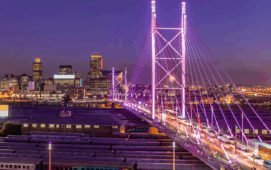Hibernia Atlantic is planning a sub 60 millisecond latency cable link between New York and London, claiming that none of its competitors will be able to beat its speed in the timeframe before the cable carries low latency data for high frequency traders in mid-2012.
Hibernia says the 60ms New York to London round trip delay – measured from 111 Eighth Avenue to Slough – will beat speeds of about 65ms achieved by competitors such as Global Crossing and Atlantic Crossing on the same route with similar end points. The cable will also outsmart Hibernia’s two existing transatlantic links that were not designed with low latency in mind and have a round trip delay of about 74ms.
Called Project Express, the cable will form part of Hibernia’s Global Financial Network and is expected not only to speed up the Atlantic crossing, but also to facilitate low latency onward connection into other key financial cities including Frankfurt, Chicago and Toronto.
Mike Saunders, vice president of business development for Hibernia, says: “We are confident that we are ahead of the game. The bottom line in reducing latency is distance. We are planning a straighter line between New York and London than ever before. There has been little improvement in cable technology over the past 15 years, but there has been some improvement in cable laying, so we are confident that the Express cable can follow a straight line and not be disturbed.”
The route Express will take knocks about 500km off the traditional route from Slough in west London to 111 Eighth Avenue in New York and with every 100km creating a roundtrip delay of about 1ms, it is this that allows Hibernia to claim the lowest latency in the market. As well as laying the cable in a straight line, it will land in England in Somerset, north east of existing cable landings and slightly nearer to Slough. Hibernia will use its own existing fibre, or buy and construct some lengths if necessary, to maintain low latency from the landing point, which has yet to be pinpointed, to Slough. It can also add connectivity into the City of London, although this will add latency.
On the London to New York route, the cable will land in Halifax, Canada and connect to existing low latency cable carrying traffic to Lynn near Boston. As in the UK, Hibernia will then build or buy backhaul to reach 111 Eighth Avenue.
Hibernia expects large investment banks, high frequency traders and other firms with financial applications that can make money out of a low latency transatlantic connection to be early users of Express, and says it is already in the final stages of making contracts with a large number of customers. “The pipe won’t be full when we go live, but we will have the number of customers we need and some won’t sign up soon enough to use the cable,” says Saunders, who adds that as well as minimum latency services the cable will carry services that do not need such low latency.
Having invested hundreds of millions of dollars in Project Express, Hibernia reckons it will cover its costs in three to four years, in part by using a new pricing model. “The pricing model for Express will be different to the norm of selling chunks of bandwidth at particular prices. Instead, we will look at the cost of laying the cable against customers’ potential to earn additional revenue and come up with a suitable pricing solution.”
Hibernia has been working on Project Express for six months and, having completed a desktop study in London, is close to awarding a turnkey contract to one of the world’s five major submarine cable manufacturers, namely Alcatel, Tyco, Huawei, Fujitsu or NEC. “We will guarantee 60ms latency, but how far below that we will be able to go depends on a marine survey that will be carried out by the selected cable manufacturer,” says Saunders. Essentially a four fibre pair optic cable system, Express will initially be lit with 40G technology, but it will be possible to upgrade to 100G technology in future.
Subscribe to our newsletter




